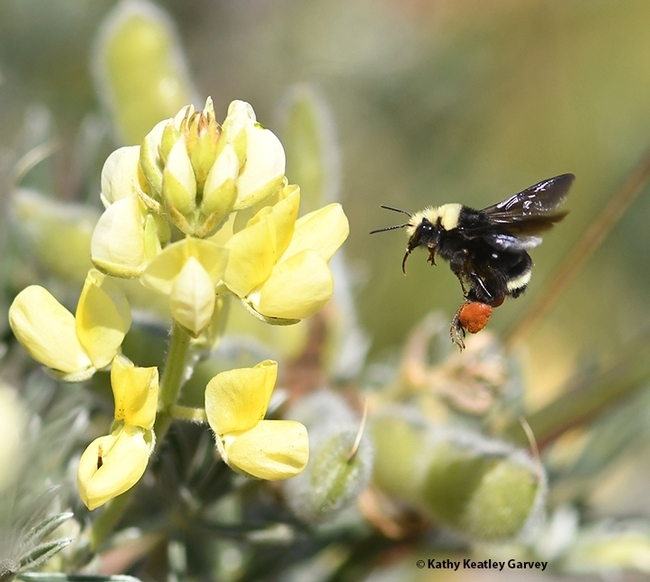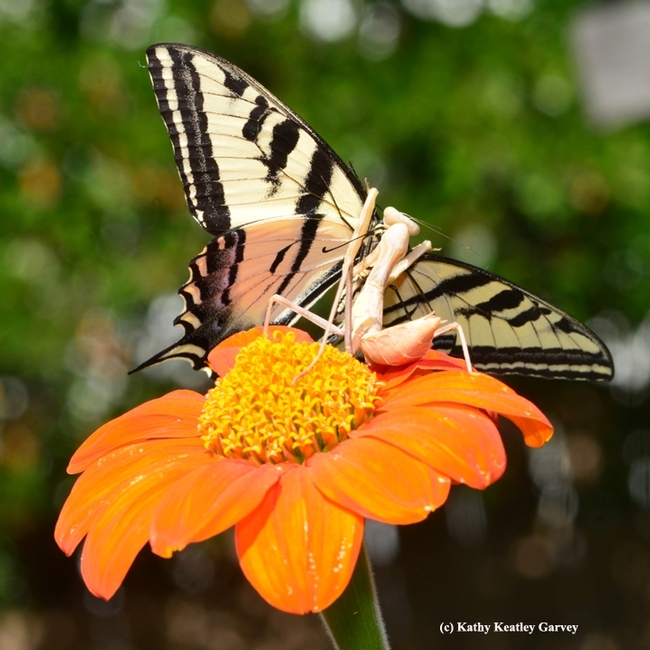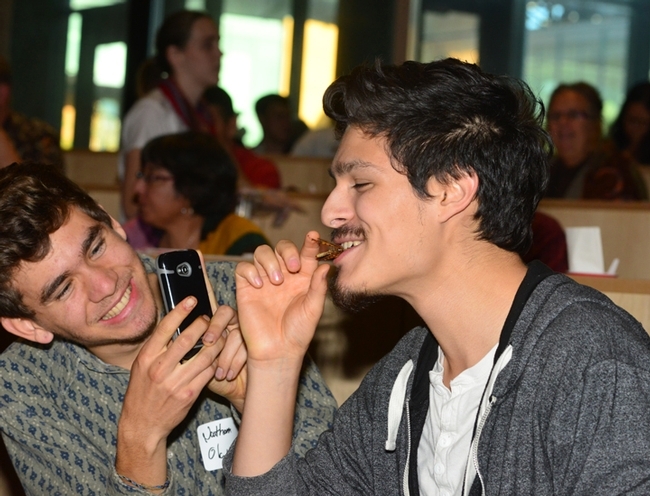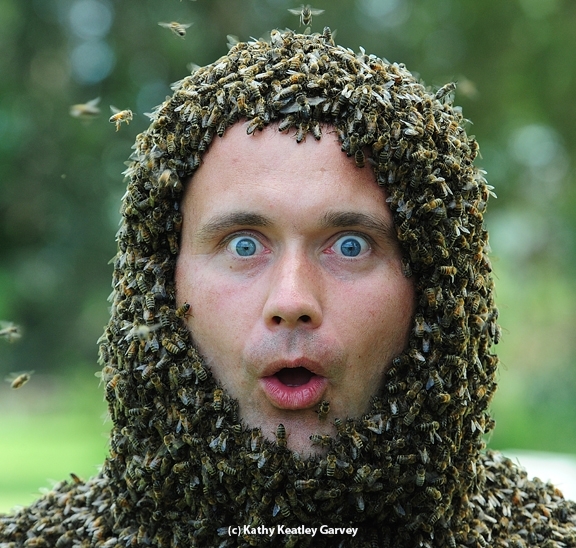- Author: Kathy Keatley Garvey

Kathy Keatley Garvey, communications specialist for the UC Davis Department of Entomology and Nematology, wrote the news article on "An Amazing Doctoral Opportunity Few Receive,” in March of 2021. The article won the “writing for newspapers” category. (See https://bit.ly/3MfuaLn)
“When five-year-old Rebecca Jean “RJ” Millena entered her kindergarten class in Concord, Calif., she immediately settled on a career choice: entomology,” Garvey began.
“An ‘About Me' poster hanging in her childhood home in Concord confirms it: ‘When I grow up, I want to be an entomologist.'
“She did and she is.”
Millena, who over a two-year-period worked as a student researcher in the laboratory of UC Davis distinguished professor Jay Rosenheim, studied the bizarre Strepsiptera endoparasites that attack their hosts, the Ammophila (thread-waisted) wasps. Millena went on to receive her bachelor's degree in entomology in 2021, and a rare four-year, full-ride doctoral fellowship from the American Museum of Natural History.
While at UC Davis, Millena studied Ammophila specimens at the Bohart Museum of Entomology, which houses a worldwide collection of more than 30,000 Ammophila (among the Bohart's eight million specimens). As larvae, members of the order Strepsiptera, known as “twisted wings,” enter theirs hosts, including wasps and bees, through joints or sutures.
Millena drew information and inspiration from UC Davis alumnus Arnold Menke, a global authority on Ammophila and author of "The Ammophila of North and Central America (Hymenoptera, Sphecidae).
“Strepsiptera are very unusual among parasites in that the parasite is visible on the outside of the host's body,” Rosenheim explained. “The head of the parasite protrudes between the sclerites on the abdomen. Looking across a growing list of species, RJ has shown that Ammophila species where mothers have more extended contact with their young--because they provision their nests with many, small caterpillars instead of one giant caterpillar-- are at much greater risk of acting as inadvertent vectors of strepsipteran parasites to their young.”
“RJ has shown that this one feature explains something like 90 percent of the total variation across Ammophila species in the risk of parasitism,” Rosenheim said. “Ecology virtually never works in such a predictable way; this is one truly exceptional counterexample of nature being highly predictable. Anyway, RJ's work shows that sometimes parental care can be a double-edged sword; we usually think of parental care as providing enhanced protection of offspring from predators and parasites. In this case, it proves to be the reverse.”
Also quoted in the news story was Lynn Kimsey, director of the Bohart Museum and a UC Davis distinguished professor of entomology: “RJ is one of those rare students that is focused, task-oriented and simultaneously creative. She was great fun to have working in the museum.”
Entomology Photo Series Award
Garvey also won the ACE silver award (second-place) for her picture story on “The Flight of the Bumble Bee,” posted June 14, 2021 on her daily (Monday through Friday) Bug Squad blog on the UC Agriculture and Natural Resources website. (See https://bit.ly/3xuoPLN)
Garvey captured in-flight images of a yellow-faced bumble bee, Bombus vosnesenskii, foraging on lupine at Bodega Bay. In her blog, she drew attention to two books: California Bees and Blooms: A Guide for Gardeners and Naturalists (Heyday, 2014), the work of University of California scientists Gordon Frankie, Robbin Thorp, Rollin Coville and Barbara Ertter; and Bumble Bees of North America: An Identification Guide (Princeton University, 2014), co-authored by Thorp (1933-2019), a UC Davis distinguished emeritus professor of entomology.
ACE, an international association of communicators, educators and information technologists who focus on communicating research-based information, will present the communication awards at its 2022 conference, set June 12-14, in Kansas City, MO.



Kathy Keatley Garvey, communications specialist with the UC Davis Department of Entomology and Nematology, won a gold or first-place award in “Writing for Newspapers”; a silver or second-place award for “Writing for the Web” and two bronze or third-place awards for her photographs, one for a feature photo and the other for a service photo.

They will receive the awards at the ACE conference, set for June 8-11 in Charleston, S.C.
Nelson's winning article, “When Good Oil Goes Bad,” looks at the award-winning biosensor a team of UC Davis students built to help ensure olive oil quality for producers, retailers and consumers. Nelson won the 2010 ACE outstanding skill award for writing.
Garvey's winning article for best news writing was a light feature on forensic entomologist Robert Kimsey's plans for a field trip to Alcatraz, a day that happened to fall on Super Bowl Sunday. It was titled "Football Game? What Football Game?" The judges gave the story a perfect score, 100 out of 100.
The judges' comments:
- “VERY clever lead. The tie-in with the football game undoubtedly drew in more readers but was not forced--it was backed up by the faculty member's quote about getting back in time for the game. The creativity of the approach and the writing cast a wide net to all readers, showing that anyone can be excited about learning and discovery - no matter their age or education level or their interest in science or insects (or football, for that matter)."
- "Word choice expresses concrete imagery--"pigskin," "rat bait," "black lights." Metaphors work-- all the bird analogies, for instance. Information is spoonfed to the reader in the most enjoyable way. Sentences pack a lot of information, movement and progression. Every sentence offers something to celebrate, including the one that ends "just like scorpions," which gives a nod to the reader, assuming that he or she does, of course, know that scorpions glow under ultraviolet light! The work-play relationship of scientist to student comes through and adds interest to the piece. The writer makes the reader feel that they are being let in on a conspiracy of discovery rather than being talked at. A certain joy and passion spring from this piece, setting it apart from the others."
- Cool topic, and the writer makes its newsy
Garvey's silver award for web writing, “What's for Lunch?”, focused on a lady beetle eating aphids. It appeared on her Bug Squad blog on the UC Agricutural and Natural Resources website. She writes the blog every night, Monday through Friday, and has never missed a post since launching it on Aug. 6, 2008.
Wrote one judge:
“I admire anyone who can write a blog a day. Congratulations. I love that that the author replies to comments from readers and is active on multiple social networks. And again, kudos on the photography.”
Garvey received a bronze award for a feature photo on her Bug Squad blog. It depicts a praying mantis eating a western tiger swallowtail.
In addition, Garvey received a bronze award for a service photo, of two participants at the 2014 “Bugs and Beer” event sponsored by the Robert Mondavi Institute for Wine and Food Science. It showed a UC Davis student and his friend sharing a bug: one photographing it and one ready to eat it.
Since 2008, Garvey has won a total of 13 gold awards from ACE for her writing and photography. She was named the recipient of the Outstanding Professional Skill Award for Writing in 2011 and the Outstanding Professional Skill Award for Photography in both 2012 and 2013.



ACE annually conducts a Critique and Awards (C&A) program that recognizes excellence in communications skills for individuals involved in the public sector – USDA, land-grant universities, state extension service or experiment stations, and international foundations.
This year Garvey won the first-place award for best feature photo with an image of a Polish scientist Jakub Gabka wearing a bee beard. The visiting scientist was part of an after-hours bee bearding event, coordinated by bee breeder-geneticist Susan Cobey, at the Harry H. Laidlaw Jr. Honey Bee Research Facility on Bee Biology Road.
Garvey's other gold award was for best "writing on the web" for her "Thankful for Insects" Bug Squad blog, posted on the UC Agriculture and Natural Resources (UC ANR website).
The bronze award was a third-place award for best series of photos on her Bug Squad blog.
The awards were presented at the organization's annual meeting, held recently in Portland, Ore.
Several other UC communicators received ACE awards at the Portland conference.
Steve Heindl, Marissa Stein and Ray Lucas of Communication Services & Information Technology won gold in the Educational Package category for the online “Introduction to Forest Management” course they produced for Rick Standiford, UC Cooperative Extension (UCCE) specialist in the Department of Environmental Science, Policy and Management at UC Berkeley.
For promotional videos, ACE awarded silver for the UC Cooperative Extension centennial video. The video was produced by the UC Office of the President's multimedia team of Jessica Wheeler, Zach Long and Larissa Branin with direction from Pam Kan-Rice and Cynthia Kintigh of the UC ANR Communication Services and Information Technology (CSIT).
“Grape Pest Management, Third Edition” won a silver award for technical publications for Larry J. Bettiga, UCCE Extension viticulture advisor in Monterey, San Benito and Santa Cruz counties, as technical editor, and CSIT editors Steve Barnett and Hazel White and CSIT designers Robin Walton and Will Suckow. They also received a bronze award for the reference book's design in the 2014 PubWest Book Design Award.
(Editor's Note: UC ANR's Pam Kan-Rice, assistant director, News and Information Outreach, Communication Services and Information Technology, contributed to this report)
DAVIS--Communications specialist Kathy Keatley Garvey of the UC Davis Department of Entomology received the top award in the category, “Writing for Newspapers,” at the 2010 conference of the Association for Communication Excellence (ACE), an international association of communicators, educators and information technologists.
Garvey's gold-winning entry, “The Young Bee Crusaders,” showcased what youth are doing to help save the bees in the face of colony collapse disorder.
Garvey, a former newspaper editor, writes the UC ANR blog, “Bug Squad,” which, as of July 25, 2010 showed one million hits from a total of 106 countries. She initiated the blog in August 2008.


